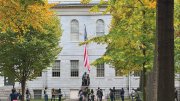Scientists may have found the Achilles heel of flu viruses. Researchers including Wayne A. Marasco, an associate professor of medicine at Harvard Medical School, and colleagues from the Centers for Disease Control and Prevention and the Burnham Institute for Medical Research, have discovered an antibody that is active against many different strains of influenza, including the 1918 Spanish flu, the H5N1 bird flu, and the largest group of seasonal flus.
Influenza viruses are particularly difficult to combat because they mutate rapidly. Thus, to fight seasonal flu—which kills roughly 40,000 Americans each year—vaccine manufacturers must try to predict which strains will dominate the next season before they can begin to develop formulations to confer immunity. Anyone who wants protection must get an annual shot.
But the discovery by Marasco and his collaborators raises the possibility of a universal flu vaccine that he says would confer “durable immunity, much like a tetanus shot,” against a range of influenza strains. The antibody targets a stable part of the viral entry mechanism that doesn’t change from year to year and is nearly identical across genetically different families of flu.
“When you are vaccinated or mount an immune response naturally,” Marasco explains, the antibodies you produce target a “lollipop-shaped protein called hemagglutinin, which has a big, globular head on a narrow stalk. That globular head is like a decoy,” he says. “It changes every season.” But the stalk does not.
In influenza infection, the hemagglutinin proteins extending from the virus attach to cell surfaces in the respiratory tract, then unfold to expose a harpoon-like fusion protein that spears the target cell membrane. The protein then twists into a hairpin formation that pulls the viral membrane and the cell membrane into tight contact.
Because the two membranes are both formed of lipids, they start to mix, and eventually a pore forms between them, as can happen between two soap bubbles. The pore then elongates to become a stable neck, allowing the viral RNA to enter the targeted cell. The virus then takes over the nucleus, hijacking the cell’s reproductive machinery to make copies of itself.
Marasco and colleagues “found a highly conserved [evolutionarily stable] region in the base of the ‘stalk’ where all the fusion machinery that the virus uses to enter the cell is located.” The naturally occurring, but rare, antibody they discovered binds to a pocket in the stalk, where its stranglehold prevents the virus from unfolding and injecting its genetic payload into another cell.
A vaccine able to prompt the human immune system to produce antibodies that would bind to this pocket would confer immunity to a broad range of flu viruses. “It is very rare that you get a chance to do this kind of really important translational work that has immediate impact,” Marasco notes. “It’s very rewarding.”
The current H1N1 swine flu pandemic already suggests that their approach will apply broadly. “The prediction would be that this universal pocket is conserved,” says Marasco—and in fact, the antibody turns out to be active against swine flu, too. The researchers are now focused on finding antibodies that will target the two other major classes of human influenza.








